2. Frame the problem and user needs
The challenges for me: Finding the real need and identifying the target user wasn't easy. It required a lot of research and networking with people, as well as deep understanding of the clients' mission and business.
3. Mapping user flow with goals
The workflow is guided by user needs and Ben Shneiderman’s mantra in data visualization: overview first, zoom and filter, then details-on-demand.
4. Design iterations
I worked very closely with the data scientists and got their feedback early to make sure the models can do what I designed. I suggested some changes to the model in order to accommodate the user's needs. For instance, the idea of giving a summary of each model, remove the jargon, and group some classifications to reduce cognitive load. On the other hand, I also gathered qualitative feedback from the users to improve the app. For instance, I found the user really cares about the accuracy of the model. However, the models don't have that kind of data. After discussing with the team, we added confidence score to each classification.
The dashboard iterations
One of the layouts I tried.
Problem: Too many labels and numbers
Picked the one using more visualizations to help summarize the situation.
Problem: Still too many labels for reaction
I had a conversation with the team and gave suggestions on how to group things. They agreed. The users like this solution a lot.
App Flow














